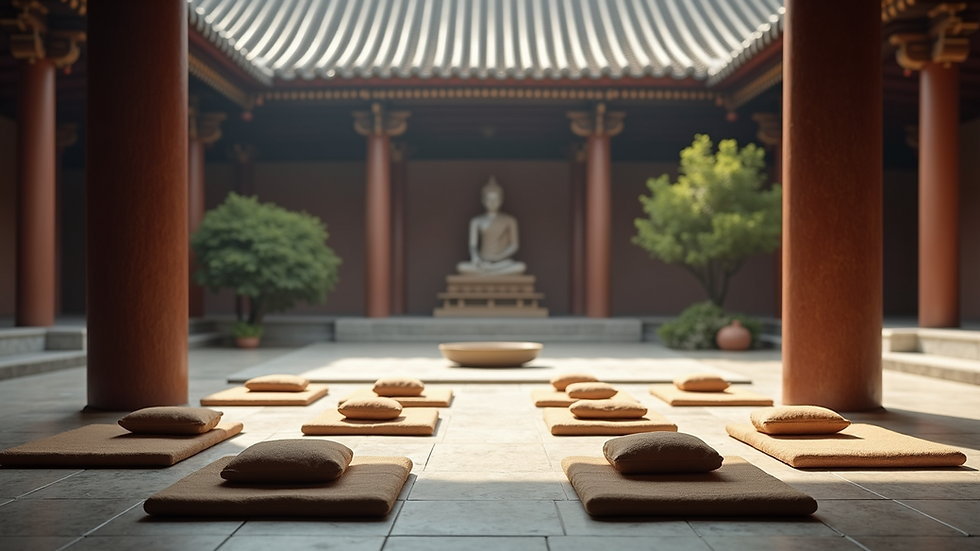Exploring Ancient Meditation Techniques
- Oct 20
- 4 min read
Meditation has been a timeless path to calm the mind and nurture the soul. As I journey through the wisdom of the ages, I find myself drawn to the gentle power of ancient meditation techniques. These practices, passed down through generations, offer us a bridge to inner peace and personal growth. They invite us to slow down, breathe deeply, and connect with the essence of our being. Today, I want to share with you some of these beautiful methods, hoping they inspire your own journey inward.
Discovering the Roots of Ancient Meditation Techniques
Meditation is not a modern invention. It has been cultivated by many cultures around the world, each adding their unique touch. From the serene temples of India to the quiet mountains of China, meditation has been a sacred art. These ancient meditation techniques were designed to help people find balance, clarity, and a deeper understanding of life.
One of the most fascinating aspects is how these techniques often blend physical posture, breath control, and focused attention. For example, in India, the practice of dhyana involves sitting still with a straight spine, focusing the mind on a single point or mantra. Meanwhile, in Taoist traditions, meditation might include gentle movements and breath work to harmonize with nature’s flow.
These methods are not just about sitting quietly; they are about awakening a profound connection within ourselves. They teach us to observe our thoughts without judgment and to cultivate a peaceful heart.

How did ancient people meditate?
Understanding how ancient people meditated helps us appreciate the depth and simplicity of their practices. They often created sacred spaces, whether a quiet cave, a temple, or a natural setting, to support their meditation. These environments were chosen for their tranquility and ability to inspire stillness.
The posture was crucial. Sitting cross-legged on the ground or on a simple mat, with the back straight and hands resting gently, was common. This posture supports alertness and comfort, allowing the mind to settle naturally.
Breath was another key element. Ancient meditators paid close attention to their breathing patterns, often slowing and deepening the breath to calm the nervous system. Some traditions used specific breathing techniques, like alternate nostril breathing, to balance energy.
Mantras or chants were also widely used. Repeating a sacred word or phrase helped focus the mind and create a rhythm that quieted mental chatter. Visualization, too, played a role—imagining light, energy, or peaceful scenes to deepen concentration.
These practices were often accompanied by ethical living and mindfulness in daily activities, creating a holistic approach to inner peace.

Practical Ancient Meditation Techniques You Can Try Today
You don’t need to travel back in time to experience the benefits of these ancient methods. Here are some simple, practical techniques inspired by the past that you can incorporate into your daily routine:
Focused Breath Awareness
Sit comfortably with your spine straight. Close your eyes and bring your attention to your breath. Notice the sensation of air entering and leaving your nostrils. If your mind wanders, gently bring it back to the breath. Practice this for 5-10 minutes daily.
Mantra Meditation
Choose a simple word or phrase that resonates with you, such as “peace” or “I am calm.” Sit quietly and repeat the mantra softly or silently. Let the sound anchor your mind and create a soothing rhythm.
Body Scan Meditation
Lie down or sit comfortably. Slowly bring your attention to different parts of your body, starting from your toes and moving upward. Notice any tension or sensations without trying to change them. This practice fosters deep relaxation and body awareness.
Walking Meditation
Find a quiet place to walk slowly and mindfully. Pay attention to each step, the feeling of your feet touching the ground, and the movement of your body. Walking meditation connects movement with mindfulness, perfect for those who find sitting still challenging.
Visualization
Close your eyes and imagine a peaceful place—a garden, a beach, or a mountain. Engage all your senses to make the scene vivid. This technique helps calm the mind and cultivate positive emotions.
By gently weaving these practices into your day, you can create a sanctuary of calm and clarity within yourself.

Embracing the Wisdom of the Past for Today’s Challenges
In our fast-paced world, the ancient wisdom of meditation offers a much-needed pause. These techniques remind us to slow down and reconnect with what truly matters. They teach patience, compassion, and resilience—qualities that help us navigate life’s ups and downs with grace.
I encourage you to explore the ancient meditation techniques that resonate with you. Approach them with an open heart and a curious mind. Remember, meditation is a personal journey, and there is no right or wrong way to practice. The key is consistency and kindness toward yourself.
As you deepen your practice, you may notice subtle shifts—a calmer mind, a lighter heart, and a clearer sense of purpose. These are the gifts of meditation, patiently waiting to be discovered.
Your Path to Inner Strength and Clarity
The journey inward is one of the most rewarding adventures we can undertake. By embracing these ancient meditation techniques, you are stepping into a tradition that has nurtured countless souls before you. It is a path of self-discovery, healing, and growth.
If you seek guidance, consider exploring resources like the Churning the Ocean Within meditation technique. Inspired by ancient wisdom, it offers accessible guided practices and a Self Reflection Journal to support your growth. Together, these tools can empower you to cultivate inner strength and clarity.
Let us embark on this journey with gentle steps and open hearts. May the timeless wisdom of meditation illuminate your path and bring you peace.
Thank you for joining me in this exploration. May your practice be filled with calm, insight, and joy.




Comments